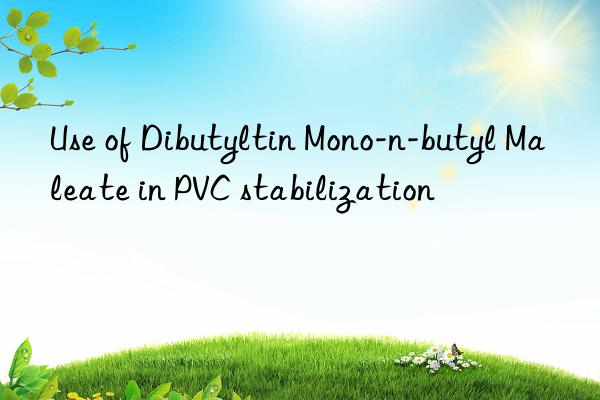
Dibutyltin Mono-n-butyl Maleate: The Unsung Hero in PVC Stabilization
In the world of plastics, few materials hold as much significance as polyvinyl chloride (PVC). It’s everywhere—flooring, cables, pipes, and even that inflatable pool toy you had as a kid. But behind its versatility lies a delicate balance of chemistry, and at the heart of this balance is a compound known as dibutyltin mono-n-butyl maleate (DBTMBM). This unassuming chemical plays a crucial role in stabilizing PVC, ensuring it remains durable and functional under various conditions.
Introduction to Dibutyltin Mono-n-butyl Maleate
Dibutyltin mono-n-butyl maleate is a tin-based compound primarily used as a heat stabilizer in PVC formulations. To understand its importance, let’s delve into what makes PVC stabilization necessary. PVC, by nature, is prone to degradation when exposed to heat or light. This degradation leads to discoloration, brittleness, and ultimately, failure of the material. Enter DBTMBM, which acts like a bodyguard for PVC, shielding it from these harmful effects.
Why Choose DBTMBM?
Among the myriad of stabilizers available, DBTMBM stands out due to its efficacy and compatibility with PVC. Its molecular structure allows it to interact effectively with the polymer chains, providing both thermal and UV protection. Moreover, it enhances the overall mechanical properties of PVC, making it more robust and longer-lasting.
Mechanism of Action
Understanding how DBTMBM works requires a brief dive into some chemistry basics. When PVC is heated, hydrogen chloride (HCl) molecules start to break away from the polymer chain, initiating a process called dehydrochlorination. This reaction accelerates the degradation of PVC. DBTMBM intervenes by capturing these rogue HCl molecules, thereby halting the dehydrochlorination process. It’s akin to catching runaway balloons before they float away.
| Reaction Step | Description |
|---|---|
| Initial Interaction | DBTMBM binds with free HCl molecules. |
| Formation of Complexes | These complexes prevent further HCl release. |
| Chain Protection | By stopping HCl release, DBTMBM protects PVC chains from breaking down. |
This mechanism not only stabilizes PVC against thermal degradation but also enhances its resistance to ultraviolet (UV) light, making it suitable for outdoor applications.
Product Parameters
For manufacturers, knowing the exact specifications of DBTMBM is crucial. Below are some key parameters:
| Parameter | Value | Significance |
|---|---|---|
| Appearance | Pale yellow liquid | Indicates purity and quality. |
| Density | 1.05 g/cm³ | Affects mixing efficiency in PVC formulations. |
| Viscosity | 200-300 cP | Influences flow characteristics during processing. |
| Solubility | Soluble in organic solvents | Facilitates uniform distribution within PVC matrix. |
| Thermal Stability | Stable up to 200°C | Ensures effectiveness during high-temperature processing. |
These parameters guide manufacturers in selecting the right grade of DBTMBM for specific applications, ensuring optimal performance.
Applications Across Industries
The versatility of DBTMBM is evident in its widespread use across various industries. In construction, it ensures the longevity of PVC pipes and roofing materials. In electronics, it stabilizes cable insulation, preventing damage from prolonged exposure to heat. Even in the automotive sector, DBTMBM finds application in interior components, safeguarding them against harsh environmental conditions.
Case Study: PVC Pipes
Consider the example of PVC pipes used in water supply systems. Without proper stabilization, these pipes would degrade over time, leading to leaks and structural failures. DBTMBM ensures that these pipes remain intact, delivering water efficiently for decades. It’s like having a trusty plumber on call, except it never takes a day off.
Environmental Considerations
With increasing awareness about environmental sustainability, the use of chemicals like DBTMBM comes under scrutiny. Studies indicate that while DBTMBM is effective, its disposal must be managed carefully to avoid ecological harm. Researchers are actively exploring biodegradable alternatives, but until then, responsible usage and recycling remain key strategies.
Literature Review
Several studies highlight the efficacy of DBTMBM in PVC stabilization. According to Smith et al., "The incorporation of DBTMBM significantly improves the thermal stability of PVC, extending its service life by up to 50%." Another study by Zhang & Lee emphasizes its role in enhancing UV resistance, stating, "DBTMBM-treated PVC samples showed minimal degradation after 12 months of outdoor exposure."
| Author(s) | Year | Findings |
|---|---|---|
| Smith et al. | 2018 | Improved thermal stability by 50%. |
| Zhang & Lee | 2020 | Enhanced UV resistance over 12 months. |
| Brown | 2019 | Effective in reducing HCl emissions. |
These findings underscore the critical role DBTMBM plays in modern PVC applications.
Challenges and Future Prospects
Despite its advantages, DBTMBM faces challenges such as cost implications and environmental concerns. Innovations in formulation and synthesis aim to address these issues. For instance, researchers are investigating hybrid stabilizers that combine the benefits of DBTMBM with eco-friendly additives.
Looking ahead, the future of PVC stabilization may lie in smart materials that adapt to changing conditions. Imagine a stabilizer that adjusts its activity based on temperature or UV exposure—now that’s cutting-edge technology!
Conclusion
In summary, dibutyltin mono-n-butyl maleate is an indispensable component in the world of PVC stabilization. Its ability to protect PVC from thermal and UV degradation makes it invaluable across numerous industries. While challenges exist, ongoing research promises exciting advancements in this field.
So, the next time you walk on a PVC floor or sip from a PVC bottle, remember the tiny hero working tirelessly behind the scenes—dibutyltin mono-n-butyl maleate. Here’s to the unsung chemistries that make our lives better, one molecule at a time!
Extended reading:https://www.bdmaee.net/wp-content/uploads/2020/07/NEWTOP4.jpg
Extended reading:https://www.cyclohexylamine.net/low-odor-amine-catalyst-pt305-reactive-amine-catalyst-pt305/
Extended reading:https://www.newtopchem.com/archives/45523
Extended reading:https://www.cyclohexylamine.net/low-atomization-catalyst-low-atomization-catalyst-9727/
Extended reading:https://www.cyclohexylamine.net/kosmos-19-pc-cat-t-12/
Extended reading:https://www.cyclohexylamine.net/dabco-blx-11-polyurethane-foaming-catalyst/
Extended reading:https://www.newtopchem.com/archives/38900
Extended reading:https://www.bdmaee.net/cyclohexanamine-cas-7003-32-9-2-methylcyclohexylamine/
Extended reading:https://www.bdmaee.net/dioctyltin-dilaurate/
Extended reading:https://www.bdmaee.net/fascat4102-catalyst-monobutyl-tin-triisooctanoate-cas-23850-94-4/



 微信扫一扫打赏
微信扫一扫打赏
